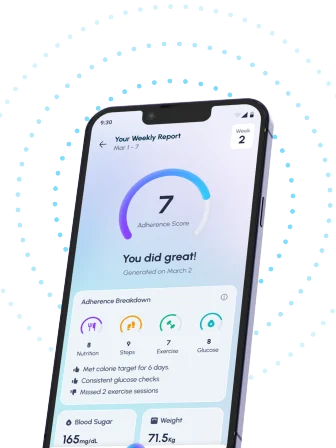Diabetes is a condition that affects millions of people worldwide. There are two main types of diabetes: Type 1 and Type 2. These two types are often misunderstood and sometimes confused with each other. One question that frequently pops up is: “Can Type 2 diabetes turn into Type 1?”
In this post, we’ll explore the key differences between Type 1 and Type 2 diabetes, clarify whether Type 2 diabetes can indeed evolve into Type 1, and offer some valuable insights on managing diabetes. By the end of this article, you’ll have a better understanding of both conditions and how to live well with them.
What is Type 1 Diabetes?
Type 1 diabetes is an autoimmune condition where the immune system attacks and destroys the insulin-producing cells in the pancreas. This leads to a lack of insulin in the body, which is essential for regulating blood sugar levels. People with Type 1 diabetes must inject insulin daily to survive. This type of diabetes typically develops in childhood or early adulthood, although it can occur at any age.
Symptoms of Type 1 Diabetes
- Frequent urination
- Extreme thirst
- Unexplained weight loss
- Fatigue
- Blurred vision
Causes of Type 1 Diabetes
The exact cause of Type 1 diabetes is still not fully understood, but it is believed to be a combination of genetic and environmental factors. In most cases, a virus or other infection may trigger the immune system to mistakenly attack the insulin-producing beta cells in the pancreas.
What is Type 2 Diabetes?
Type 2 diabetes is a metabolic disorder in which the body becomes resistant to insulin, or the pancreas is unable to produce enough insulin to maintain normal blood sugar levels. Unlike Type 1, Type 2 diabetes is more common in adults and is often linked to lifestyle factors such as poor diet, lack of exercise, and obesity. However, genetics can also play a significant role.
Symptoms of Type 2 Diabetes
- Increased thirst
- Frequent urination
- Fatigue
- Blurred vision
- Slow-healing sores
Causes of Type 2 Diabetes
The primary cause of Type 2 diabetes is insulin resistance, where the body’s cells do not respond to insulin as efficiently. Over time, the pancreas works harder to produce more insulin, but eventually, it can’t keep up, leading to elevated blood sugar levels.
Can Type 2 Diabetes Turn into Type 1?
One of the most common misconceptions about diabetes is that Type 2 diabetes can somehow turn into Type 1 diabetes. While both conditions affect blood sugar regulation, they are fundamentally different in their causes, and Type 2 cannot “convert” into Type 1. Here’s why:
Different Causes
- Type 1 diabetes is caused by an autoimmune reaction that destroys insulin-producing cells in the pancreas. This is not something that happens in Type 2 diabetes.
- Type 2 diabetes, on the other hand, is caused by insulin resistance and, later, a decline in insulin production. It’s more about how the body responds to insulin rather than a complete failure of the pancreas.
Distinct Mechanisms
In Type 2 diabetes, the pancreas may still produce some insulin, but it’s either not enough or the body’s cells are resistant to it. In Type 1 diabetes, however, the pancreas is unable to produce insulin at all. These distinct mechanisms make it impossible for Type 2 diabetes to “turn into” Type 1 diabetes.
So, What Happens in Type 2 Diabetes Over Time?
While Type 2 diabetes doesn’t turn into Type 1, it can worsen over time if not managed properly. As the disease progresses, the insulin-producing cells in the pancreas can become overworked and damaged, leading to decreased insulin production. This can make it harder to manage blood sugar levels, and in some cases, people with Type 2 diabetes may eventually require insulin therapy, which is a hallmark of Type 1 diabetes. However, this does not mean their Type 2 diabetes has turned into Type 1.
Can Type 2 Diabetes Become More Severe?
While Type 2 diabetes doesn’t turn into Type 1, it can worsen over time, leading to complications like:
- Pancreatic burnout: Over time, the pancreas may not be able to produce enough insulin due to the stress of constant insulin resistance.
- Insulin dependency: Some people with Type 2 diabetes may eventually need to take insulin injections, although this is usually after other treatments (like oral medications or lifestyle changes) fail to control blood sugar.
Risk Factors for Severe Type 2 Diabetes
- Obesity: Excess weight can make it harder for your body to use insulin properly.
- Sedentary lifestyle: Lack of physical activity contributes to insulin resistance.
- Poor diet: Eating foods high in sugar and unhealthy fats can worsen insulin resistance.
- Genetics: Family history plays a major role in Type 2 diabetes risk.
The Importance of Early Detection and Management
Whether you have Type 1 or Type 2 diabetes, early detection and proper management are crucial for preventing complications. Here are some tips for managing Type 2 diabetes and preventing it from worsening:
1. Healthy Eating
Eating a balanced diet that’s rich in fruits, vegetables, lean proteins, and whole grains can help control blood sugar levels. Avoid foods that cause sharp spikes in blood sugar, such as sugary snacks, soda, and processed foods.
2. Regular Exercise
Physical activity helps your body use insulin more efficiently and can also aid in weight management. Aim for at least 150 minutes of moderate-intensity exercise per week.
3. Monitor Blood Sugar Levels
Regularly checking your blood sugar levels will help you understand how your body responds to food, exercise, and medication. This is essential for preventing complications like diabetic ketoacidosis (DKA) or hyperglycemic episodes.
4. Medication and Insulin
Many people with Type 2 diabetes are initially prescribed oral medications to help manage their blood sugar. However, some may eventually need insulin or other injectable medications. Always follow your doctor’s guidance and keep track of any changes in your condition.
5. Weight Loss
Losing weight can help improve insulin sensitivity and reduce the strain on your pancreas. Even a modest amount of weight loss can make a significant difference in blood sugar management.
Treatment Options for Type 2 Diabetes
The treatment for Type 2 diabetes focuses on managing blood sugar levels and preventing complications. Here are some options that may be recommended:
- Oral Medications
- Metformin: The most common medication prescribed for Type 2 diabetes. It helps the body use insulin more effectively.
- Sulfonylureas: These stimulate the pancreas to produce more insulin.
- DPP-4 inhibitors: Help regulate blood sugar by affecting the digestive enzymes.
- Insulin Therapy
In cases where oral medications are no longer effective, insulin therapy may be necessary. This doesn’t mean the person has Type 1 diabetes, but it means their Type 2 diabetes is harder to manage. - Lifestyle Changes
- Dietary changes: Focus on low-carb and high-fiber foods to stabilize blood sugar.
- Exercise: Engaging in regular physical activity is one of the best ways to manage Type 2 diabetes.
- Bariatric Surgery
For people with severe obesity and Type 2 diabetes, weight-loss surgery may help improve insulin sensitivity.
Expert Contributions
Dr. Ramesh Iyer, Endocrinologist at AIIMS Delhi, explains:
“Type 2 diabetes does not convert into Type 1, but it can progress to a stage where insulin is necessary. This is not the same as an autoimmune attack on beta cells.”
Recommendations Grounded in Proven Research and Facts
1. Get the Right Diagnosis
- If your doctor suspects Type 1 diabetes or LADA, request an autoantibody test.
- C-peptide tests can measure insulin production levels.
2. Manage Type 2 Diabetes Effectively
- Follow a low-carb, high-fiber diet.
- Engage in regular exercise to improve insulin sensitivity.
- Take prescribed medications as directed.
3. Monitor Blood Sugar Levels Closely
- Frequent glucose monitoring helps track disease progression.
- Watch for symptoms like excessive thirst, fatigue, or unexplained weight loss.
4. Understand Insulin Therapy
- Needing insulin does not mean your Type 2 diabetes turned into Type 1.
- Insulin therapy can improve quality of life and prevent complications.
Factual and Reliable Information
Scientific research supports that Type 2 diabetes remains Type 2, even if insulin is required.
FAQ: Can Type 2 Diabetes Turn Into Type 1?
1. Can Type 2 Diabetes become Type 1?
No, Type 2 diabetes cannot turn into Type 1. They are two distinct conditions with different causes.
2. Can a person with Type 2 diabetes require insulin?
Yes, over time, some people with Type 2 diabetes may need insulin if other treatments no longer keep blood sugar levels under control.
3. Is Type 2 diabetes reversible?
While Type 2 diabetes is not technically “curable,” it can often be managed or even put into remission through lifestyle changes like diet and exercise.
4. What are the complications of Type 2 diabetes?
Untreated or poorly managed Type 2 diabetes can lead to heart disease, kidney failure, nerve damage, and vision problems.
Conclusion: Understanding Diabetes and Staying Healthy
In conclusion, Type 2 diabetes does not turn into Type 1 diabetes. The two conditions are fundamentally different in their causes and mechanisms. Type 2 diabetes is a metabolic disorder where the body becomes resistant to insulin, while Type 1 is an autoimmune condition that destroys insulin-producing cells in the pancreas. However, Type 2 diabetes can worsen over time, and people with the condition may eventually require insulin therapy.
The key to living well with Type 2 diabetes is early detection, effective management, and lifestyle changes like eating a healthy diet, exercising regularly, and monitoring blood sugar levels. With the right care, people with Type 2 diabetes can lead healthy, fulfilling lives.



